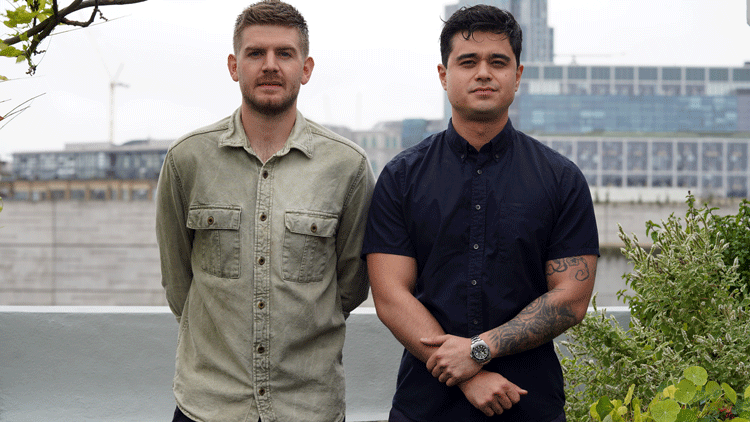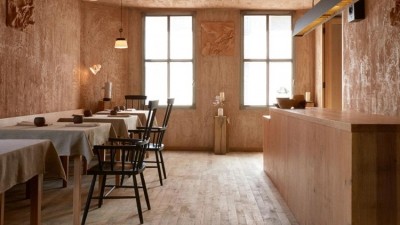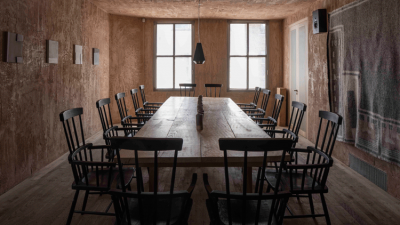Maos 2.0: this time it’s personal

Back in July, diminutive Shoreditch restaurant Maos announced that it was ditching its communal dining approach - the restaurant’s small dining room being home to just one single table around which 16 diners would sit - in favour of a more traditional restaurant approach. Given that the lockdown in England had not long been lifted and that restaurants had to adhere to distancing measures that would such a communal approach impossible, it wasn’t an unexpected move.
Yet, far from being a move thrust upon them by Government restrictions, it was a result of a decision taken long before Coronavirus even reached these shores.
So says executive chef Edoardo Pellicano who, having fully taken over the running of the kitchen following the departure of chef Nuno Mendes earlier in the year, has overseen the creation of what is affectionately being dubbed Maos 2.0 alongside the restaurant and Blue Mountain School (which houses Maos) founder James Brown.
Thus the restaurant has been re-imagined, with a maximum of nine guests seated in the main dining room - with an option to sit at a pass within the room - and a further six guests in a private dining room known as the Chef’s Table next to the restaurant’s small kitchen.
As part of the move, Charlie Sims, who has spent the past four years at Noma where he worked in the first iteration of the restaurant in Copenhagen as well as travelling to Tulum and Sydney for the restaurant’s residencies, has been appointed general manager. Together he and Pellicano are on a mission to make Maos not just one of the most singular high-end dining experiences in London, but also one of the best.
Maos 2.0
On the face of it, turning a 16-cover communal dining restaurant into a 15-cover one split between two small rooms doesn’t sound like a great shake up. Yet it marks a significant change to the founding principle of Maos as an immersive experience that sought to the bring the intimateness and in many ways unpredictability of a supper club or dinner party within the more rigorous restaurant framework.
At the original Maos, guests were actively encouraged to move around the restaurant at their will, whether to pop into the kitchen to have a chat with the chefs, or into the restaurant’s wine room to sample some wine (as one might at a friend’s dinner party) with dishes on the multi-course menu often served in situ so that all diners would eat at the same time, wherever they were. It was a ballsy and ambitious approach, but also somewhat impractical.
“It was a lovely idea,” admits Pellicano. “Rather than having to be sat down in the same seat for four hours, to be able to move around was great for diners, but we felt it needed more structure and that we needed to take a step back. Giving people this freedom also meant that if they were in the wine room and we served food there the temperature was different, which meant plates of food dropping temperature much quicker. The finer details were compromised.”
The pair had conversations before lockdown about making Maos a bit more of a personal experience. “We found that a little bit hard with 16 guests that sit around this communal table,” adds Pellicano. “We also wanted to focus more on the food and the attention to detail. It was quite challenging service 16 people all at once and making sure temperatures were OK.”
What did work was the interaction between chefs and diners and between different groups diners, but this also had it drawbacks. “Being able to be in the kitchen watching the chefs cook - there are not many places where you can have experience. But then people were sat on the stairs eating a course. It sometimes descended into chaos to have people everywhere.”
More traditional, but no less ambitious
Maos 2.0 might be a little more traditional in its approach - diners are no longer given the freedom to roam the back of house areas at their leisure, and individual tables mean no more strangers sat together - but it is no less ambitious.
In fact, the changes finally allow the restaurant to get the attention to detail it craves. Rather than having the pressure of cooking 16 dishes simultaneously the brigade only has to do a more manageable maximum of nine at any one time owing to the split sitting of the restaurant: guests at the Chef’s Table sit down to eat at 6pm and dinner in the main dining room commences at 8:15pm (with the 10pm curfew the timings are 5.45pm for the Chef’s Table and 7.15pm in the dining room).
“The way we cook is precise, it’s also very temperature sensitive,” says Pellicano. “The idea was to serve the lobster as it had just come out of the oven or the beef just off the grill, and it got lost when it was sitting on the pass for a minute or so while we did 16 plates. It led to a little bit of inconsistency.
“The changes have elevated the experience with things being served straight away. It’s a lot more controlled. This feels like this is the way to move forward.”
Having a pass in the dining room has also meant that the close interaction with chefs remains. Those guests sat at the pass have a ring side view of the chefs as they plate the dishes, but the modest size of the dining room means that all diners are in close proximity to the action. “You see more action now than you did before,” says Pellicano.
The move away from communal dining has also taken some of the pressure off the restaurant in terms of creating the right atmosphere. Having groups of strangers sat together on the same table was not without its challenges.
“When it works it created an incredible buzz, but I’ve worked in other places where they seat 20 guests at a communal table and it’s so inconsistent in terms of the energy of the room depending on who’s visiting on the night,” says Sims.
“One group of people on the table can really affect the rest even if it’s four people on a table of 16. If their energy is in any way negative or disruptive that can have a big impact. You can have a table of 20 which is really 10 different tables of two and the amount of work you have to put in to generate an energy if everyone is introvert or on their phones can be hard. Now we can much more consistently deliver at the high level we aspire to.”
Dishes are still intended to be served to the entire room at the same time to give people the feeling they are experiencing something together (“that communal feeling when you taste the dish is something we love,” says Pellicano) although if one table is eating at a markedly slower pace the kitchen will stagger service accordingly.
“Of course, we adapt to each table. Some people would like you to be a bit more formal than others,” adds Sims. “The ambition is to have a dynamic, energetic, fun, warm atmosphere. When there is chemistry between tables, we encourage it, but it is dependent on the guests there on the night.
Reaction to change
The changes might make operational sense, but how have loyal guests reacted to them?
“Return guests know it’s a very different experience and they have this anticipation to see how different it is,” says Sims. “People who had been many times said of course they loved the experience, but they said they also had to mentally prepare themselves every time they came.
“It wasn’t just going out for dinner, you had to think whether you were in the right frame of mind to sit with 15 strangers and make conversation. People previously booked the whole room to have it to themselves so they could say and do their own thing and totally relax. On the whole they have been positive.”
The length of the meal has also been cut - the 10pm curfew reducing it further - even though it still consists of around 14 dishes. “What was intimidating was the length of the meal,” says Pellicano. “Especially during the week. To sit down for four to five hours is a huge commitment.”
What hasn’t changed is the approach to food, which remains as focused as it has ever been. Under Mendes Maos cooked a freeform menu that took inspiration from across the world, and this style has continued now that Pellicano, who worked with Mendes at his East London restaurant Viajante before being part of the opening team of Maos, has taken fully the reins.
Michelin’s inspectors have been impressed, with the restaurant being awarded a star in the 2020 guide.
The cooking is intricate, precise, sometimes surprising, sometimes divisive with Pellicano saying the move away from communal dining has allowed him to push the envelope a bit further and be even more precise and a la minute in style.
Despite its length, the menu comprises snacks and small plates, but it is not a procession of tiny bites; more substantial dishes play an important part in delivering what he describes as a “burst of tastes”.
Recent dishes he says he’s most proud of include lobster poached in beef fat and a dessert of acorn ice cream served with melting slivers of jamon Iberico.
The very nature of Maos as an unapologetically ambitious restaurant - ‘a restaurant dedicated to culinary freedom and exploration’ is its mission statement - and the foodie clientele this invariably attracts allows Pellicano and team to try and offer dishes diners will not have seen anywhere else in the capital, and play around with ingredient combinations, flavours and textures that more everyday places would not get away with. This doesn’t mean a meal here is some sort of avant garde culinary experience, but it does allow for a more experimental bent to the menu in places.
“We’re not challenging people for the sake of it, that’s just our style of cooking. There’s a nice balance between things that are challenging and comforting, that’s the way I like to cook.
“I don’t want course after course of things that are confusing, which is why the structure of the menu is so important, it takes a lot of thinking. You can have something that is quite challenging followed by something quite comforting that brings you back down to normality. I want it to feel natural.”
The menu has what Pellicano calls crowd pleasers, such as its cuttlefish dumplings, but then other dishes such as a cross breed beef served with wasabi and yuzu kochi can be divisive. “Some people are like ‘this is the best dish I’ve ever had’, some people are like ‘that doesn’t work’.
“Not everyone is going to love every single course, we accept that, but it’s how we want to cook and the food and drink we want to serve. It’s something we believe in, and it’s important to stay true to that. I want people to leave the restaurant and still be thinking about it the next day.”
A meal costs £170 in the dining room and £200 at the Chefs Table, with wine pairing and additional £125.
The drinks pairings follow in a similar vein. As well as the wine pairing for the first time the restaurant has introduced a non-alcoholic drinks pairing as well as a half and half menu of wines and juices. Non-alcoholic options include house-made kombuchas, juices based on symbiotic cultures from Mexican tibicos grains and tea mushroom cultures from northeastern China, developed using seasonal ingredients together with ‘living water’ that is prepared on site.
As with the food, not everything served might be to everybody’s palate. “It’s nice to have pairings that divide opinion,” says Sims. “But to keep provoking people for the sake of it is not an enjoyable experience. Overall people say they found it fantastic but might not be sure about one pairing or a particular dish but were also happy to have had the experience.”
A post pandemic future
The restaurant’s small size, and a business model that relies on a relatively small number of covers a week, means that both Pellicano and Sims are feeling “very positive” about what the future holds in spite of the capital’s hospitality sector continuing to be hit hard by the pandemic. Their focus, they say, is to keep making improvements to the restaurant to make it into a world class dining destination.
As part of this, the next chapter will be incorporating the building’s roof terrace into the experience, with diners at the Chef’s Table climbing the art installation-like staircase to the top floor, with views over east London, for a post-prandial tea service in the newly created tea library. The library is focused on teas from China’s southwestern province of Yunnan, rare matcha varieties, handmade Japanese green teas, as well as natural and hand processed varieties from Japan, Korea, and India to make for a refined end to the meal.
“We don’t want to stand still. We have built an amazing foundation and want to nail what we are doing right now, and then constantly look at how we can layer and add to it,” says Pellicano, who adds the intention is to reintroduce allowing people into the kitchen and bringing chefs back to serving food in the wine cellar when the time is right.
“It would be nice to have people coming into the kitchen again but in more of a structured way rather than the free-for-all around four different rooms like last time. We have so much potential to evolve and the capability to do something amazing here.
“With the amount of covers we have we can really push it. We’re going to create one of the best dining experiences in London.”















